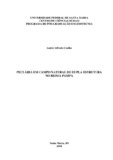| dc.creator | Coelho, André Alfredo | |
| dc.date.accessioned | 2018-08-22T19:55:55Z | |
| dc.date.available | 2018-08-22T19:55:55Z | |
| dc.date.issued | 2018-01-26 | |
| dc.identifier.uri | http://repositorio.ufsm.br/handle/1/14077 | |
| dc.description.abstract | The double structure grassland is an important food base for a cattle breeding in the state of Rio Grande do Sul. In this scenario, where the change and the change of structure, the investigation of patterns and processes of operation are fundamental to the management guidelines. Thus, we investigate the dynamics of the vegetation of a field of the physiographic region of the Southeastern Serra, submitted to continuous and rotational grazing. It was observed that management methods interfered in the composition of the forage mass without interfering without positive performance of the animals. In a compilation and adaptation of methods proposed to deduce the weight gain observed in rearing heifers, considering the verified vegetation dynamics. Logo of the middle of the project, understanding a proposal of a conceptual model for a minimal support solution in double structure fields. In addition, some impacts of rotational and continuous management on the vegetation state are oriented, suggesting that the lower management of the grazing process in the continuous control can lead the grassland to degradation states. However, the accumulation of biomass occurring in rotational grazing may not advocate increasing animal stocking without loss of ecosystem functionality. Having accumulated some information about the management of rural diversity, these are compiled in a closing chapter, with no intention of extending knowledge to practice. Finally, it was emphasized the importance of improving the minimum support model for double structure grassland. | eng |
| dc.description.sponsorship | Coordenação de Aperfeiçoamento de Pessoal de Nível Superior - CAPES | por |
| dc.language | por | por |
| dc.publisher | Universidade Federal de Santa Maria | por |
| dc.rights | Attribution-NonCommercial-NoDerivatives 4.0 International | * |
| dc.rights.uri | http://creativecommons.org/licenses/by-nc-nd/4.0/ | * |
| dc.subject | Capacidade mínima de suporte | por |
| dc.subject | Padrões | por |
| dc.subject | Processos | por |
| dc.subject | Minimum support capacity | eng |
| dc.subject | Patterns | eng |
| dc.subject | Processes | eng |
| dc.title | Pecuária em campo natural de dupla estrutura no bioma Pampa | por |
| dc.title.alternative | Livestock in a double structure grassland in the Pampa biome | eng |
| dc.type | Dissertação | por |
| dc.description.resumo | O campo natural de dupla estrutura é uma importante base alimentar para a bovinocultura do Rio Grande do Sul. Neste cenário, onde a pecuária altera e é alterada pela estrutura campestre, a investigação de padrões e processos de funcionamento são fundamentais às diretrizes de manejo. Sendo assim, investigou-se a dinâmica da vegetação de um campo da região fisiográfica da Serra do Sudeste, submetidos a pastoreio contínuo e rotativo. Observou-se que os métodos de manejo interferiram na composição da massa de forragem sem interferir no desempenho positivo dos animais. Em seguida uma compilação e adaptação de métodos foram propostos para deduzir o ganho de peso observado nas novilhas em recria, considerando haver a dinâmica da vegetação verificada anteriormente. Logo o desempenho animal pôde ser parcialmente compreendido, sugerindo a proposta de um modelo conceitual para a capacidade mínima de suporte em campos de dupla estrutura. Além disso alguns impactos dos manejos rotativo e contínuo no estado da vegetação investigada foram abordados, sugerindo que a menor gerência sobre o processo de pastejo ocorrente no manejo contínuo, pode conduzir o campo a estados de degradação. Porém o acúmulo de biomassa ocorrente no pastoreio rotativo, pode não preconizar o aumento da lotação animal sem que hajam perdas na funcionalidade do ecossistema. Acumuladas algumas informações referentes ao manejo da diversidade campestre, compilou-se estas em um capítulo de fechamento, no intuito da extensão do conhecimento à prática. Por fim, ressaltou-se a importância do aprimoramento do modelo da capacidade mínima de suporte para campos de dupla estrutura. | por |
| dc.contributor.advisor1 | Quadros, Fernando Luiz Ferreira de | |
| dc.contributor.advisor1Lattes | http://lattes.cnpq.br/9202266292366562 | por |
| dc.contributor.referee1 | Trindade, José Pedro Pereira | |
| dc.contributor.referee1Lattes | http://lattes.cnpq.br/7976647947215420 | por |
| dc.contributor.referee2 | Silveira, Vicente Celestino Pires | |
| dc.contributor.referee2Lattes | http://lattes.cnpq.br/9996388016752276 | por |
| dc.creator.Lattes | http://lattes.cnpq.br/0842139024338139 | por |
| dc.publisher.country | Brasil | por |
| dc.publisher.department | Zootecnia | por |
| dc.publisher.initials | UFSM | por |
| dc.publisher.program | Programa de Pós-Graduação em Zootecnia | por |
| dc.subject.cnpq | CNPQ::CIENCIAS AGRARIAS::ZOOTECNIA | por |
| dc.publisher.unidade | Centro de Ciências Rurais | por |



